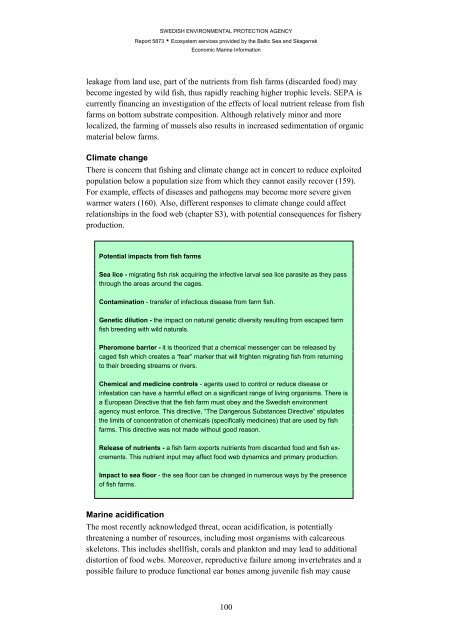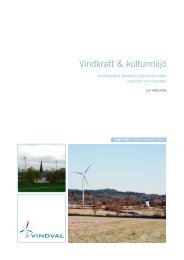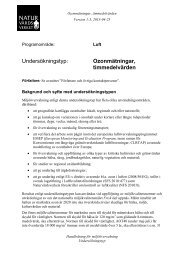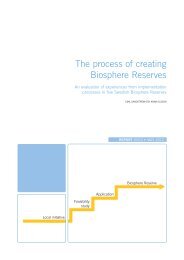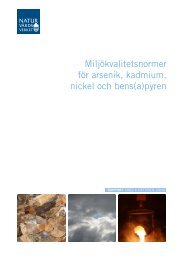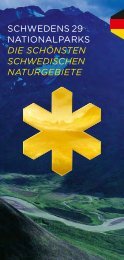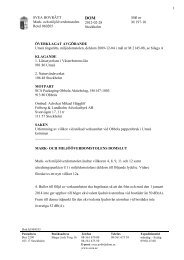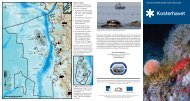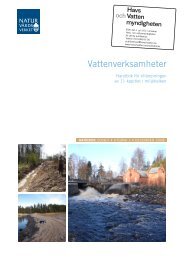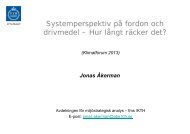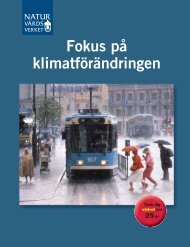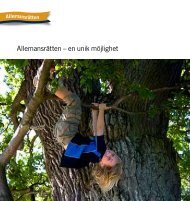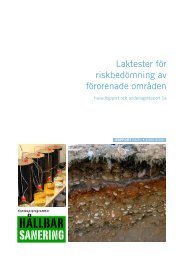Ecosystem services provided by the Baltic Sea ... - Naturvårdsverket
Ecosystem services provided by the Baltic Sea ... - Naturvårdsverket
Ecosystem services provided by the Baltic Sea ... - Naturvårdsverket
Create successful ePaper yourself
Turn your PDF publications into a flip-book with our unique Google optimized e-Paper software.
SWEDISH ENVIRONMENTAL PROTECTION AGENCY<br />
Report 5873 • <strong>Ecosystem</strong> <strong>services</strong> <strong>provided</strong> <strong>by</strong> <strong>the</strong> <strong>Baltic</strong> <strong>Sea</strong> and Skagerrak<br />
Economic Marine Information<br />
leakage from land use, part of <strong>the</strong> nutrients from fish farms (discarded food) may<br />
become ingested <strong>by</strong> wild fish, thus rapidly reaching higher trophic levels. SEPA is<br />
currently financing an investigation of <strong>the</strong> effects of local nutrient release from fish<br />
farms on bottom substrate composition. Although relatively minor and more<br />
localized, <strong>the</strong> farming of mussels also results in increased sedimentation of organic<br />
material below farms.<br />
Climate change<br />
There is concern that fishing and climate change act in concert to reduce exploited<br />
population below a population size from which <strong>the</strong>y cannot easily recover (159).<br />
For example, effects of diseases and pathogens may become more severe given<br />
warmer waters (160). Also, different responses to climate change could affect<br />
relationships in <strong>the</strong> food web (chapter S3), with potential consequences for fishery<br />
production.<br />
Potential impacts from fish farms<br />
<strong>Sea</strong> lice - migrating fish risk acquiring <strong>the</strong> infective larval sea lice parasite as <strong>the</strong>y pass<br />
through <strong>the</strong> areas around <strong>the</strong> cages.<br />
Contamination - transfer of infectious disease from farm fish.<br />
Genetic dilution - <strong>the</strong> impact on natural genetic diversity resulting from escaped farm<br />
fish breeding with wild naturals.<br />
Pheromone barrier - it is <strong>the</strong>orized that a chemical messenger can be released <strong>by</strong><br />
caged fish which creates a “fear” marker that will frighten migrating fish from returning<br />
to <strong>the</strong>ir breeding streams or rivers.<br />
Chemical and medicine controls - agents used to control or reduce disease or<br />
infestation can have a harmful effect on a significant range of living organisms. There is<br />
a European Directive that <strong>the</strong> fish farm must obey and <strong>the</strong> Swedish environment<br />
agency must enforce. This directive, “The Dangerous Substances Directive” stipulates<br />
<strong>the</strong> limits of concentration of chemicals (specifically medicines) that are used <strong>by</strong> fish<br />
farms. This directive was not made without good reason.<br />
Release of nutrients - a fish farm exports nutrients from discarded food and fish excrements.<br />
This nutrient input may affect food web dynamics and primary production.<br />
Impact to sea floor - <strong>the</strong> sea floor can be changed in numerous ways <strong>by</strong> <strong>the</strong> presence<br />
of fish farms.<br />
Marine acidification<br />
The most recently acknowledged threat, ocean acidification, is potentially<br />
threatening a number of resources, including most organisms with calcareous<br />
skeletons. This includes shellfish, corals and plankton and may lead to additional<br />
distortion of food webs. Moreover, reproductive failure among invertebrates and a<br />
possible failure to produce functional ear bones among juvenile fish may cause<br />
100


